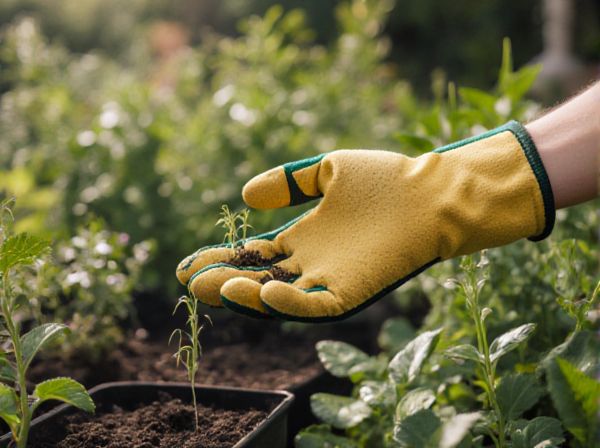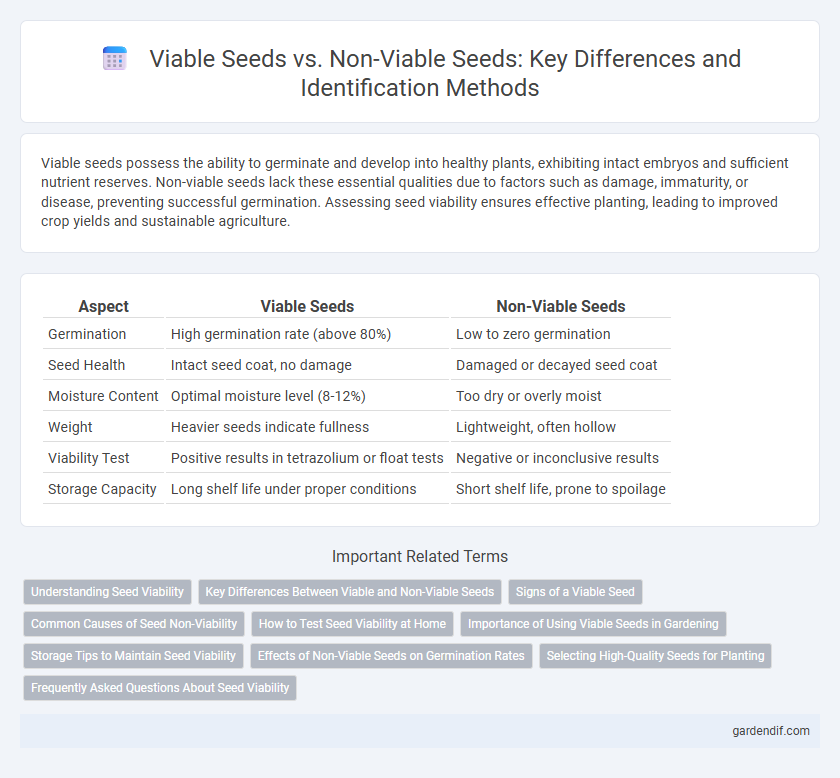
Viable seeds vs Non-viable seeds Illustration
Viable seeds possess the ability to germinate and develop into healthy plants, exhibiting intact embryos and sufficient nutrient reserves. Non-viable seeds lack these essential qualities due to factors such as damage, immaturity, or disease, preventing successful germination. Assessing seed viability ensures effective planting, leading to improved crop yields and sustainable agriculture.
Table of Comparison
| Aspect | Viable Seeds | Non-Viable Seeds |
|---|---|---|
| Germination | High germination rate (above 80%) | Low to zero germination |
| Seed Health | Intact seed coat, no damage | Damaged or decayed seed coat |
| Moisture Content | Optimal moisture level (8-12%) | Too dry or overly moist |
| Weight | Heavier seeds indicate fullness | Lightweight, often hollow |
| Viability Test | Positive results in tetrazolium or float tests | Negative or inconclusive results |
| Storage Capacity | Long shelf life under proper conditions | Short shelf life, prone to spoilage |
Understanding Seed Viability
Viable seeds possess the essential biological capacity to germinate and develop into healthy plants, characterized by intact embryo cells and sufficient nutrient reserves. Non-viable seeds lack these qualities due to factors like genetic defects, damage, or age-related deterioration, resulting in failure to sprout. Understanding seed viability is critical for optimizing crop yields and ensuring efficient seed storage and planting strategies.
Key Differences Between Viable and Non-Viable Seeds
Viable seeds contain living embryos capable of germination under suitable conditions, exhibiting intact seed coats and proper moisture levels, while non-viable seeds lack these crucial traits, often appearing shriveled or discolored. The germination potential of viable seeds usually exceeds 80%, ensuring successful plant growth, whereas non-viable seeds fail to sprout due to embryo damage or environmental stress. Seed viability tests like the tetrazolium test and germination tests provide accurate distinctions essential for agriculture and restoration projects.
Signs of a Viable Seed
Viable seeds exhibit firm, plump textures and consistent coloration, indicating healthy embryo development essential for germination. When subjected to a float test, viable seeds typically sink due to their density, contrasting with non-viable seeds that float. The presence of a hard seed coat and lack of visible damage or discoloration are further reliable signs confirming seed viability.
Common Causes of Seed Non-Viability
Common causes of seed non-viability include genetic defects, poor storage conditions, and environmental stress during seed development. Exposure to excessive moisture, temperature fluctuations, and fungal infections can significantly reduce seed viability. Mechanical damage during harvesting and improper handling further contribute to the deterioration of seed quality and germination potential.
How to Test Seed Viability at Home
Testing seed viability at home can be effectively done using the water float test and the germination test. For the float test, place seeds in a container of water; viable seeds typically sink due to their density, while non-viable seeds float as they are hollow or damaged. Alternatively, conduct a germination test by placing seeds on a damp paper towel inside a plastic bag, keeping them warm and moist for several days to observe how many seeds sprout, which indicates their viability percentage.
Importance of Using Viable Seeds in Gardening
Using viable seeds is crucial for successful gardening as they ensure higher germination rates and healthier plant development. Non-viable seeds can lead to wasted time, resources, and space due to their inability to sprout. Selecting seeds with proven viability supports robust crop yields and sustainable garden growth.
Storage Tips to Maintain Seed Viability
Viable seeds retain their ability to germinate and develop into healthy plants, making proper storage essential to extend viability. Storing seeds in cool, dry, and dark conditions with low humidity levels below 8% significantly slows metabolic processes and prevents mold growth. Using airtight containers, such as glass jars with moisture absorbers and refrigeration between 32degF to 41degF (0degC to 5degC), maximizes seed longevity while maintaining germination rates.
Effects of Non-Viable Seeds on Germination Rates
Non-viable seeds significantly reduce overall germination rates by occupying space and resources that viable seeds could utilize for successful growth. The presence of non-viable seeds often leads to uneven seedbed coverage, resulting in patchy crop emergence and lower stand density. Managing seed quality through proper testing and sorting techniques is essential to improve germination efficiency and maximize yield potential.
Selecting High-Quality Seeds for Planting
Selecting high-quality seeds involves identifying viable seeds with healthy, intact seed coats, indicating strong potential for germination and robust plant growth. Viable seeds typically exhibit firmness, uniform color, and absence of damage or discoloration, unlike non-viable seeds that are often shriveled, discolored, or hollow, reducing germination success. Prioritizing viable seeds improves crop yield, ensures resource efficiency, and supports sustainable agricultural practices.
Frequently Asked Questions About Seed Viability
Viable seeds contain a living embryo capable of germination under favorable conditions, while non-viable seeds lack this potential due to damage or age. Seed viability is typically tested using methods such as the germination test, tetrazolium test, or float test to ensure high germination rates for planting. Understanding seed viability helps optimize crop yield, conserve genetic resources, and improve seed storage practices.
Viable seeds vs Non-viable seeds Infographic

 gardendif.com
gardendif.com